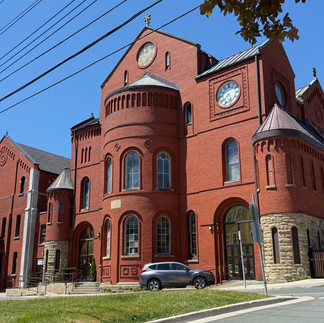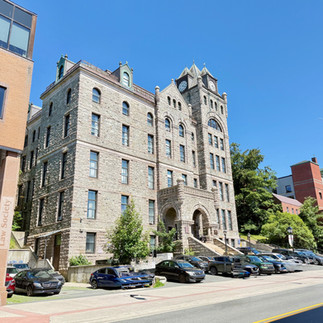St. John’s, NL: A Charming City Frozen in Time
- Kim Martinez

- Jul 17
- 5 min read

We spent three days exploring St. John’s, Newfoundland, and it wasn’t at all what I expected. Two years ago, we made a brief stop in the city on a foggy, crowded day—wires crisscrossed the streets, parking was impossible, and without a plan, we quickly left, dismissing it as just another bustling urban center.
But this time, we returned with a strategy—and discovered one of my favorite cities. Steeped in history, oozing charm, and surprisingly easy to navigate, St. John’s feels like stepping into a time warp where the past and present coexist seamlessly.
Quick Facts About St. John's
- Oldest City in North America – Fishing settlements here date back to the early 1500s. (Yes, maybe older than St. Augustine, Florida—though the exact "oldest city" title depends on how you measure it!)

- A Historic Harbor – For centuries, St. John's natural harbor served as a vital fishing and trading post for Basque, Portuguese, French, and English fishermen—and it's still a working port today.
- A Colonial Battleground – The city changed hands between the British and French multiple times before Britain secured control in 1762.
- WWII Naval Base – During World War II, St. John's was a crucial Allied naval base, protecting Atlantic convoys.
- Historic Firsts – Site of the first transatlantic wireless communication (1901) and the first non-stop transatlantic flight (1919, Alcock and Brown).

A Walk Through History
St. John's feels more like a historic town than a modern city. The architecture, much of it unchanged for over a century, makes it easy to imagine life here 150 years ago. Unlike many tourist-heavy historic districts, St. John's is filled with locals shopping at independent stores, adding to its authentic, lived-in charm.
A Day in St. Johns
We arrived around 9:30 AM and easily found metered parking on a side street near Duckworth Street—one of the city's three main downtown thoroughfares. Walking downhill toward the harbor, we were immediately surrounded by beautifully preserved 19th-century buildings, including the striking Supreme Court building, whose cornerstone was laid by King George (then the Duke of York). Remarkably, it still serves its original purpose—justice is dispensed here just as it was over 125 years ago.
First Stop: Rocket Bakery
Our morning began at Rocket Bakery on Water Street. Their cinnamon rolls were the best I've had in Newfoundland—moist, generously spiced, and utterly delicious. Even the coffee stood out (and I rarely bother mentioning coffee!). Though they offer lunch, we fueled up and moved on.
Exploring Water Street & Beyond

Water Street, one of the oldest commercial streets in North America, is lined with independent shops and historic buildings. Unlike tourist traps found in other historic cities, these stores cater to locals as much as visitors. Highlights include:
- Nonia – Handknit wool goods made by local artisans.
- Fred's Records – An iconic music shop for vinyl lovers.
- The Newfoundland Chocolate Company – A must for sweet tooths.
- Christina Parker Gallery – Showcasing local artists, not mass-produced souvenirs.
Jelly Bean Row & the 1892 Fire
Jelly Bean Row Houses
No visit to St. John's is complete without seeing Jelly Bean Row—the vibrant, candy-colored houses that define the city's aesthetic. Most were built after the Great Fire of 1892, which destroyed much of downtown. Yet, because the city retains its original narrow streets and pedestrian walkways, these homes feel like a natural part of the landscape rather than a preserved relic.
The Rooms
The Rooms: Where History Meets Stunning Views
Perched on a hill overlooking the city, The Rooms is a must-visit. This modern museum and art gallery is architecturally stunning, designed to echo the fishing "rooms" (processing sheds) of Newfoundland's outports. The real showstopper? The three-story atrium with floor-to-ceiling windows offering panoramic views of the harbor and downtown.
We planned to stay for an hour—but lost track of time watching the fog roll in like a living storm. The museum's exhibits (art, history, and culture) are so engrossing that you could easily spend a full day here.
George Street: The Heart of Nightlife
A short walk from Water Street, George Street is famous for its pubs and live music. Though we visited in the late afternoon, the happy hour crowd was already filling the bars. With its pedestrian-only strip and legendary venues, it's easy to see why this is the place to be after dark.

Dinner at YellowBelly Brewery

Hungry after a long day, we headed to YellowBelly Brewery & Public House, housed in a building that survived the 1846 fire—one of the few remaining mid-19th-century commercial structures in Canada. The stone and brick interior feels like stepping into a historic tavern.
I ordered the blackened fish tacos (fantastic), while Manny tried their YellowBelly Burger and a house-brewed beer (both excellent). Service in Newfoundland is something special—staff are genuinely warm, proud of their city, and eager to share recommendations.
Fun fact: The name "Yellowbelly" comes from an Irish hurling team from County Wexford who wore yellow sashes—King George III supposedly cheered, "Well done, the Yellowbellies!" after their victory.
A Working Harbor, Not a Postcard
Unlike Halifax's polished waterfront, St. John's harbor is still industrial—fishing boats, cargo ships, and rugged docks dominate the scene. But that's part of its charm. Walking along Harbor Road as the fog rolled in felt like stepping into a centuries-old maritime tradition.
Quidi Vidi: A Hidden Gem
Just a 15-minute drive from downtown, the fishing village of Quidi Vidi is a postcard-perfect escape. Colorful houses, a quiet harbor, and a slower pace make it the ideal spot to unwind. Don't miss the Quidi Vidi Brewery or a stroll along the charming waterfront.
Why St. John's Feels Like a Time Warp

- No Chain Sprawl – Instead of generic franchises, you'll find saltbox-house cafés, family-run shops, and pubs with decades-old recipes.
- Landmarks Still in Use – The Basilica of St. John the Baptist (1855), Commissariat House (1830s), and Signal Hill aren't just museums—they're living parts of the city.
- Minimal Modern Intrusions – Unlike cities where skyscrapers overshadow history, St. John's keeps high-rises at bay, preserving its small-town feel.
Final Thoughts
St. John's is one of the safest cities in Canada, and its residents—descendants of Irish, Scottish, French, and English settlers—are fiercely proud of their home. They support local businesses, cherish their history, and welcome visitors with open arms.
We only scratched the surface in exploring the downtown of St. Johns but —Cape Spear (North America's easternmost point), Signal Hill, and Pippy Park Golf Club are still on our list for this visit so we are going to have to put a return visit to St. Johns on our growing lists of our next trip to Newfoundland.
"In St. John's, history isn't just preserved—it's still open for business. From a 130-year-old tea shop to a fish-and-chips joint serving the same batter since the 1950s, these places aren't museums; they're living, working relics of the city's past." This is a city where time moves differently. And we can't wait to return.
























Comments